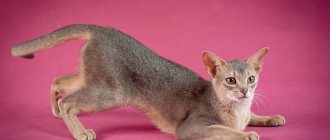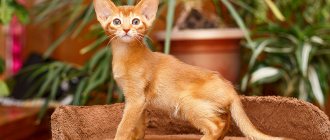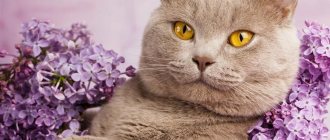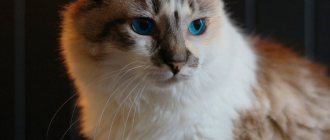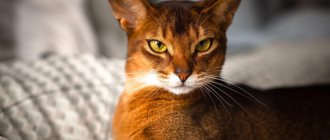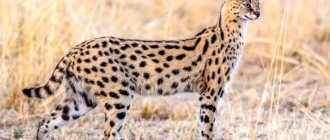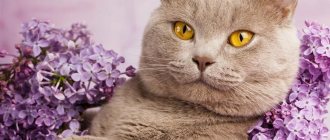The Abyssinian cat is a regal, graceful beauty with lined, almond-shaped eyes. Although Abyssinians are aware of their own exclusivity, narcissism is not characteristic of them. Their flexible, friendly character and easy-going nature make them wonderful companions and everyone’s favorites. Cats delight even the most inveterate dog lovers and delight the eye with delightful colors: sorrel, wild, blue and fawn. In this article we will talk about the unique blue color and its genetics, we will talk about the character traits of the Abyssinian cat and the conditions of its keeping.
History of the Abyssinian cat breed
There is no single version of the origin of this breed. Felinologists identify several theories, but none of them can be called reliable.
The first version tells us about a beauty named Zula, whom Captain Barrett-Lenard brought to England from Ethiopia in 1868. Information about Zula’s offspring has not been preserved, but this particular cat has become the subject of close study by breeders involved in indigenous African cats.
In 1951, experts were able to determine the genotype of mummies stored in the British Museum since 1907. An autopsy revealed that the animals were mummified between 600 and 200 CE. BC e. Most cats were similar to modern Abyssinians. Later, genetic testing confirmed the relationship of the Abyssinians with native cats from Ancient Egypt.
However, representatives of the modern Abyssinian breed are not considered direct descendants of Egyptian cats due to striking differences in appearance. However, the blood of these animals played an initial role in the formation of the Abyssinian breed.
The first Abyssinians had much in common with the subspecies of the Libyan steppe cat, so most experts are of the opinion that the Abyssinians descend from them.
In addition, scientists discovered in the blood of representatives of the breed an admixture of South Asian murkas, which are characterized by ticking. In cat populations native to Africa, this color is less common.
The second version of the origin of the breed tells that it arose at the beginning of the 19th century. thanks to the fusion of Ethiopian aboriginal cats with European shorthair tabby cats.
The first Abyssinians were shown to the world at an exhibition in 1871. You could admire representatives of unusual nature at the Crystal Palace. The limbs were decorated with stripes, which the breeders got rid of over time. Until the beginning of the twentieth century. The animals' ears were decorated with tassels, which enhanced their attractiveness.
At that time, exotic beauties delighted the eye with a variety of fur coat colors. The most common beauties were silver in color with a striped pattern.
Unfortunately, during the Second World War, the Abyssinian population decreased greatly, and the breed was on the verge of extinction. By the end of the war, 12 individuals remained in Britain. Fortunately, at the beginning of the twentieth century. The first representatives of the breed were brought to the USA, where breeders had more opportunities for the development of Abyssinians.
Interesting. In the post-war period, two branches of the breed were developed - American and European. In the USA and Europe, Abyssinians have gained enormous popularity, but in the CIS they remained exotic for a long time.
Appearance of the Abyssinian cat
The Abyssinian blue cat is flexible and muscular. The long, slender limbs allow the animals to reach distances that are six times their body length. Males are slightly larger than females. The weight is the same for everyone - 3-4.5 kg. The Blue Abyssinian is harmoniously built and graceful.
Head, eyes, ears, neck
The dimensions of the wedge-shaped head are proportional to the body. The cheekbones are smoothed, the back of the head smoothly flows into the neck. The bridge of the nose is straight, the stop is smooth. The chin is rounded, the muzzle is graphic. Males have pronounced cheeks.
Expressive almond-shaped eyes are set wide at a slight angle. The breed standard does not allow an oriental or rounded cut. The eyes are sparkling, amber, copper or green, as if lined with a black pencil. Blue cats have green irises. The halo is thin, light, matching the undercoat.
The ears are large, set wide and slightly inclined. The ears are wider at the base, narrowing and rounded closer to the tips. The inner surface of the ears is covered with vellus fur, in the center there is a bald spot, as if from a thumb. Funny woolen brushes stick out of the ears.
The neck is elongated, thin and graceful.
Body, limbs, paws, tail, fur
The body is elongated, flexible, harmoniously folded. The chest is rounded, there is a slight deflection on the back.
The limbs are long, thin, strong. The paws are large, oval, the toes are small, pressed tightly against each other.
The tail is long, thick at the base, narrowed at the end.
The coat is short, thick, soft and silky to the touch, and tickles in the sun. The hairs on the back are longer than on the body.
Generally recognized colors
The peculiarity of Abyssinian cats is that they are not born with a “ready” color. The final color appears as the animal matures: kittens are darker than adults. The breed is also characterized by a multidimensional coat color: at the base, each hair is light, and closer to the tip it acquires a darker color. According to its tone, the hair can be divided into 3-4 zones.
The Cat Fanciers Association (the world's largest association for owners of breeding animals) allows only four colors of Abyssinians. These are “ruddy”, blue, “fawn” (“fawn”) and “sorrel”.
"Wild" (Ruddy)
The most common color of the breed. Ticked color, the owners of which are characterized by the following:
- The predominant shade is rich reddish brown.
- The base of each hair is light. The tip of the hairs is black. Each hair is ticked.
- Dark brown, almost black legs.
- The nose is brick (reddish-red) in color.
Ruddy colored cats:
Blue
The second most common color of Abyssinian cats. Blue is a conventional name: a cat’s fur can be visually identified as gray-beige with a silvery tint. It seems that the animal’s grayish coat is illuminated from the inside with a soft beige light.
This effect is achieved by ticked, multidimensional hair coloring. At the base they are light, beige or creamy pinkish. Towards the tip the hair darkens - gradually acquires a silver-blue and then a dark gray tone. An exception for multidimensional coloring is the “palms” and “heels” of the animal. They should be dark gray in color.
Blue cats:
"Faun" ("fawn")
From the name you can judge that this is a delicate fawn, beige cat with a dark cinnamon pattern. The “fawn” coloring is one of the rarest among representatives of the Abyssinian breed.
The hairs of such cats at the base are light fawn, light beige or pinkish-beige. Towards the tip they gradually darken to a warm dark brown tone, a cocoa shade. The skin on the nose and paw pads is pinkish or dark cream. The “fawn” color of the Abyssinian is valued for the pinkish glow of the cat’s coat.
Faun cats:
"Sorrel" ("bay", "sorrel")
This color is one of the most common among Abyssinians. Visually, the animal’s fur looks golden, richly copper. On top of this beautiful color is a chocolate coating.
The ticked fur at the base is yellowish-brown (this gives a “copper” or “gold” effect). Towards the tip of the hair the tone changes to a rich chocolate brown.
The back parts of the animal’s legs, “palms” and “heels” are plain, cocoa-colored. The nose is pinkish.
Sorrel cats:
Features of the color of Abyssinians
The Abyssinian cat has beautiful, shiny fur that lies close to the body. A distinctive feature of the breed is the alternation of dark and light areas on the fur. This amazing coat pattern is called ticking and is due to the dominant agouti gene.
Uniform coloring of the guard hairs and undercoat leads to the fact that a clear pattern is not formed on the body. The breed standard does not allow stripes and rosettes, light areas on a dark background. The exception is the white chin of some representatives of the breed. This type of undercoat is welcome - rich color at the tips and muted at the base. This type is called wildcat.
The first attempts at crossing led to the appearance of long-haired and unevenly colored offspring. Modern breeders suggest that as a result of such a merger, individuals without ticking were born, which were subsequently not registered.
What is ticking
The “coat” of an Abyssinian cat is dense, shiny, perfectly smooth, fits well to the body, short, without a pattern on the tail and paws. A distinctive feature, which is a kind of “business card” of the Abyssinian breed, is the coloring of each hair in different (dark, light) shades at the same time.
Such a non-standard, rare pattern is called ticking, and the reason for its occurrence lies in the special predominant agouti gene “A” (agouti) present in the genotype. It is thanks to him that the colors of Abyssinian cats do not have the characteristic tabby pattern inherent, for example, in British Shorthairs.
Ticking (zonal color) can be double or triple. Preference is given to the latter species, as it is the rarest.
The cat's entire body is evenly colored, but if you draw it against the fur, you can see a clear, bright undercoat, a tone lighter than the main color. Abyssinian cats do not acquire full coloring immediately, but after a year and a half. An Abyssinian kitten will not have such a bright aesthetic color at an early age.
At first, his fur looks dull and uncolored, but as he matures, the “ugly duckling” will turn into a magnificent royal individual with an amazingly beautiful, bright “fur coat.”
The coat of an adult animal should not have spots, rosettes or stripes, with the exception of white spots on the collar and chin. The richness of the ticking should not be obscured by the depth of the coloring.
If a cat of the Abyssinian breed has disadvantages in the form of differences between the main color and the shade of the paw pads, “rings” on the tail and paws, darkened spots under the chin, visually reminiscent of a closed necklace (marking), a “fur coat” of a dull gray cold tone, then these signs serve as grounds for disqualification.
Today, the International Association CFA (Cat Fanciers' Association) officially recognized the following colors of the Abyssinian cat breed: wild, blue, sorrel, fawn.
Genetics of the blue Abyssinian color
Melanin is a coloring pigment responsible for the color of hair. It comes in two types: eumelanin (responsible for the black color) and pheomelanin (responsible for the red color). It follows that there are only two main colors - black and red.
Black colors are characterized by several shades, which are determined by the following genes:
- B - black (dominant);
- b - dark brown color (dominant to bl, recessive to B),
- bl - light brown (recessive).
When you first look at wild-colored Abyssinians or Sorrel cats, they appear to have a red coat, but genetically speaking, they are black.
The coloring of the breed's representatives is determined by eumelanin, not pheomelanin. The light brown and sandy areas on the hairs are formed by eumelanin. Light brown or yellow colors are obtained due to the low pigment density.
Yellow and brown stripes are formed due to the oxidation of the black pigment eumelanin. Sorrel is essentially a light brown color. Sand color is the prerogative of eumelanin.
The color of the Abyssinians is formed due to the color itself and its tone. The dominant D gene and the recessive D gene give rich and light colors. The blue color is a bleached wild, and the fawn is a bleached sorrel.
The wild color appears due to the combination of black color and rich tone - BB (Bbl) + DD (Dd).
Blue color is a combination of black and light colors. In other words, the color genes are combined with the dd pair.
Sorrel is a combination of cinnamon (sorrel) and rich tone: bl bl + DD(Dd).
Fawn - clarified sorrel: bl bl + dd.
In pedigrees, colors are designated by the letters n, o, a, p. The Abyssinian breed has the abbreviation ABY.
The b gene, responsible for the dark brown pigment, was not initially identified in Abyssinians. However, breeders bred cats of chocolate and lilac colors, which have not yet received official recognition.
Reference. Kittens receive 60% of genes from the manufacturer's cat, and therefore high demands are placed on males. Mating with a purebred representative of the breed is expensive and, interestingly, it is not always possible to agree on it.
Wild color of the Abyssinian
The natural colors of Abyssinian cats are fresh, bright and sunny. The wild color combines red and brown tones, and the transitions are smooth and gradual, without a clearly defined boundary. The nose and paw pads must be brick red. The end of the hairs is light, and the beginning is dark.
Recently, the federation began to allow various variations of this color, including silver and cool shades, but conservative breeders have not yet fully accepted the proposed changes.
What colors do Abyssinian cats have?
The CFA officially recognizes four colors of Abyssinian cats: ruddy, sorrel, red, blue and fawn.
Abyssinian cat wild color
The original coat color of the Abyssinian cat is wild, which until 1963 Ruddy was the only official color.
The hairs alternate between areas of dark brown, black and burnt ocher on an orange-brown background. It looks truly fantastic. The inner surface of the limbs and the lower abdomen are painted in a uniform orange color without a pattern. The brighter the color, the more valuable the representative of the breed.
A dark brown or black stripe runs along the back to the tip of the tail. The tip of the wild Abyssinian's tail is black.
The iris of the eyes is golden, hazel or green. At birth, the iris is dark blue. The color changes after two months. There is an opinion that the time the eye color changes affects the brightness of the shade - the slower the iris changes, the more intense the eye color in an adult cat.
The nose of Ruddy Abyssinians is brick red with a dark brown border. The paw pads are black or dark brown, in harmony with the main color.
Sorrel color
The Red color or Abyssinian sorel was officially recognized in 1963, and until 1979 it was called red.
Abyssinian Sorrel cat
A distinctive feature of sorrel is the alternation of copper-red color with chocolate brown. The main coat color on the body, belly and limbs is rich apricot. A red-brown stripe runs down the back and changes to a chocolate brown color towards the tip of the tail.
The iris of Abyssinians is copper in color - gold, copper, green or nut. The nose is bright pink with a brick-red border. The paw pads are pink, with tufts of soft chocolate brown fur between the toes.
Blue color
The blue color was recognized by members of the GCCF association in 1984.
The ticked hairs alternate between a light blue-gray color and rich blue-gray areas. The undercoat is fawn with a warm pink-beige, cream or apricot tint. The inner surface of the legs and lower abdomen are painted the same color. A dark blue stripe runs down the back.
The iris of the eyes is gold, green, copper or hazel. An important condition is that the color must be bright.
The nose is blue-gray or brick-red, with a dark blue-gray rim. The paw pads are pinkish-purple in color, with blue tufts of fur between the toes.
Fawn color
The fawn or beige color was most recently recognized in 1989. The shade of the coat changes as the animal matures: at the age of three months after the first molt, ticking appears. Warm pink-beige color is combined with dark pink-beige ticking. The belly, undercoat and inner surface of the legs are colored ivory.
Abyssinian cat color Fawn
The Abyssinian Faun has a dark pink-beige stripe along its back. Closer to the tip of the tail, the stripe takes on a deep beige-pink hue.
The nose is light pink with a dark pink border. The paw pads are light pink, with soft pink-beige tufts of fur between the toes. The iris ranges from copper-gold to hazel and green.
The fawn color is rare. It's all due to recessive genes in color, which appear when two recessive genes are combined. The fawn color consists of bbdd genes. If you combine a wild color without the recessive BBDD genes with a faun, then the litter will contain kittens of exclusively wild color. If the mating of a wild individual and a faun produced offspring of sorrel color, then the wild color has the Bb genotype, if blue, then the wild color carries the Dd lightening gene, if fauns appeared, then the wild color carries the BbDd gene.
The more kittens a couple has, the higher the chances of finding out the genotype of the wild partner. When a fawn cat is mated to a fawn cat, offspring of identical color are produced.
Description, appearance, standard, color
Abyssinians differ from their relatives in their plastic body, rare color, small size and weight, as well as leanness. They have large almond-shaped eyes and a very intelligent look.
The weight of animals does not exceed 4 kg for females and 6 kg for males. Life expectancy is 15-20 years. Also read about how many years cats live.
Breed standards:
- Height – no more than 30 cm for cats and 35 cm for cats.
- Wedge-shaped head, elegant neck, wide ears and located at a considerable distance from each other.
- One of the features is the rim around the entire perimeter of the eyes, the color of which can be either green or amber.
- Long paws and tail, narrow oval shaped paw pads.
- The body is covered with smooth, short, thick fur, which has four permitted colors: fawn, wild, blue and sorrel.
Characteristics of colors
The fawn or “fawn” color is manifested by a light brown shade of fur with markings reminiscent of the color of cocoa.
Wild is recognized as the most common and comes in all shades of ocher; kittens are born with black markings on the face and tip of the tail.
Sorrel is a cinnamon red color. Cats of this color have a reddish-red hue with chocolate markings on the face and tail.
Blue Abyssinians have warm beige and gray coats with slate gray markings.
Photos of Blue Abyssinians
Possible deviations
Disadvantages of the breed:
- narrow or rounded skull;
- stripes on legs;
- drawing on the body;
- prominent cheekbones;
- light undercoat;
- fuzzy ticking;
- round eyes;
- small ears;
- flabby muscles;
- short legs and tail;
- lack of dark eyeliner around the eyelids;
- light areas on the coat;
- pointed muzzle;
- "fox" look.
Sorrel colors
The most common color of the Abyssinian breed. The color is very rich, bright and honey, and ticking is present throughout the entire surface of the coat - from dark brown to red. Brown eye rims are allowed, as well as small zonal darkening in the head and tail area.
Abyssinians are aristocratic and incredibly beautiful animals, whose fans include such eminent people as David Bowie and Zhanna Friske. I found the colors of Abyssinian cats in the photo gallery here - you can once again admire the graceful creatures.
Care and maintenance
Abyssinian cats are easy to care for. They are undemanding and unpretentious in food, but special attention will have to be paid to their health. It is important to maintain the vitality of animals at the proper level.
Kittens are a little shy, so on the first day in a new home, pay attention to the baby, be affectionate, and introduce him to other pets and family members. Do not overload the kitten with games, give time to get used to the new environment.
Abyssinian cats prefer to explore the territory on their own. The owner’s role in this matter is not to interfere, to provide a comfortable place to sleep, to provide a house, a tray, bowls for water and food, and a scratching post.
Hygiene
Abyssinian kittens are easily litter trained. Breeders advise choosing a tray based on the size of the pet. When choosing a filler, pay attention to silica gel or clumping. The woody one holds the smell well, but sticks to the paws and scatters on the floor, which causes a lot of trouble for the owners.
It is better to start cutting nails and water treatments from an early age in order to avoid problems with hygiene in the future. Bath days are rarely arranged - once during a period of intense molting is enough. Shampoos for short-haired cats without fragrances are used for washing. After bathing, the fur is blotted with a terry towel and the cat is released to dry.
Teeth cleaning is performed once every 3-4 months. Representatives of the breed are prone to the formation of tartar and plaque, so the owner must monitor oral hygiene.
Once a week, wipe the ears and eyes with a damp cloth or cotton pads soaked in clean water and special lotions.
Wool
A short fur coat should be combed once a week with a stiff brush or rubber mitten. Abyssinian cats shed lightly once a year. Severe hair loss indicates allergies or other health problems. To find out the reasons, it is recommended to consult a veterinarian.
Nutrition
Abyssinians are unpretentious in food and enjoy eating both natural products and dry food. If the owner is a follower of natural nutrition, cats will be given special complexes as an additional source of vitamins and minerals to maintain beautiful fur, healthy bones and muscles.
It is important not to overfeed animals and follow the daily norm. Kittens up to one year old are fed three times a day, adults - twice a day.
Remember, cats are obligate carnivores. The basis of their diet is animal proteins. The body copes worse with carbohydrates, but this does not mean that they have no place in their menu. The diet should contain no more than 10% carbohydrates. Cats can be given boiled white fish and meat, fresh vegetables and fruits.
Nutrition
For Abyssinian cats, both dry food and canned food from leading cat food manufacturers, as well as natural products, are suitable.
Animals need dry food of at least premium, and preferably super premium and holistic class. Small kittens are transferred to an adult diet after they reach 10 months of age.
Natural products can and should be included in the feeding process of both a kitten and an adult. The main thing is that the meat and fish are boiled or well frozen and without bones. Eggs are allowed both raw and boiled to enrich cottage cheese or cereal porridge.
Prohibited Products
A sample diet looks like this:
- Once a week by-products, chicken or beef;
- 1-2 times a month sea fish;
- every 2-3 days beef;
- chicken can be given every other day;
- for small kittens cream or milk daily;
- weekly for adult cats - kefir or fermented baked milk;
- 2 times a week boiled yolk;
- for small kittens under 12 weeks of age, liquid porridge with oatmeal, semolina or rice every other day;
- 2 times a week low-fat cottage cheese mixed with a raw egg;
- 2-3 times a week, pre-boiled and chopped vegetables.
Sprouted oats and wheat can be purchased at zoological stores or grown yourself. Brewer's yeast and sunflower oil are also introduced into the diet.
Character
Abyssinians are active and inquisitive animals, striving to understand the world around them. They retain such passion and playfulness until old age. Representatives of the breed are smart, balanced, intelligent and affectionate. They are not prone to aggression, do not use their claws during games, and are patient with children, even if they do not know how to show love.
Abyssinian cats do not sit still and are constantly looking for something to do. They love to sit on cabinets and watch their household.
Representatives of the breed are clean and neat. They do not damage property, do not chew plants or rummage through flower pots, do not ride on chandeliers or use curtains as a Swedish slide.
Breeders advise not to let cats out onto balconies and to close the windows. Natural curiosity pushes Abyssinians to act recklessly - they can easily jump from a height of the seventh floor after a pigeon, which is fraught with dire consequences. Porcelain, crystal and any fragile items should be removed from view.
Abyssinians are endowed with self-esteem and will not tolerate disrespectful treatment. Cats prefer to sit next to a person and only occasionally climb onto their laps.
Owners compare their pets to dogs: they are just as loyal, playful and easy to train. For example, an Abyssinian can be trained to fetch small thrown objects. bringing abandoned items.
Cats do not abandon kittens; they feed and raise their offspring without outside help.
Representatives of the breed need human love and attention. Physical and visual contact with the owner is important for them; without this, cats develop depression and psychosomatic disorders.
Interesting Facts
The Abyssinian cat loves all members of the household, but chooses a “favorite owner” to follow on his heels and take part in all his affairs.
Another feature of the breed is the energy that flows like a fountain. Running around the apartment and jumping from heights is a common activity for them. Restless climbers will love the floor-to-ceiling playhouse, which features multiple levels, hanging toys and a place to play hide-and-seek.
Some owners of the breed claim that their pets are able to hypnotize with their gaze.
During active games, Abyssinians can suddenly fall asleep in a bizarre position.
Representatives of the breed can disguise themselves as ferrets and climb rocks.
Abyssinians are quiet. They use their voice only to tell their owner how glad they are to see him.
Representatives of the American line are large in size and have shorter hair, while Europeans are distinguished by their harmonious build and have a characteristic “cat smile”.
Among the Abyssinians, “girls” are born 3-4 times less often than “boys”. Therefore, a cat with a fawn color is a rare and desirable phenomenon.
Abyssinian cats are extroverts and perceive loneliness as an ordeal.
Modern genotype research conducted by the University of Davis disproves the domestication theory of African wild cats. In fact, the genotype of Abyssinians is far from the genotype of African cats from Egypt and Tunisia, the Middle East and Asia. Therefore, a reliable version of the origin of the breed still does not exist, which gives rise to many speculations that have nothing to do with reality.
